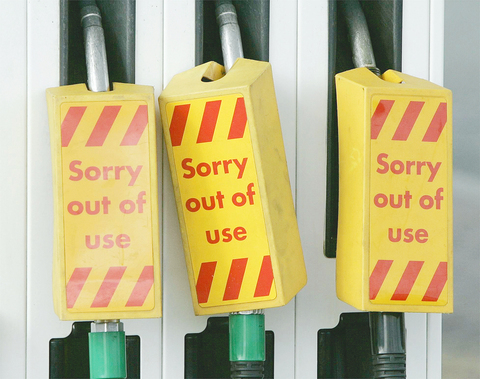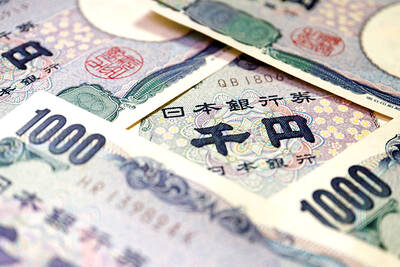In its February, 1920 issue, the National Geographic Magazine wondered, in an article by George Otis Smith, the director of the US Geological Survey, "Where will our children get it when American wells cease to flow?"
By that time -- only 60 years after the world's first oil well came on stream at Titusville, Pennsylvania -- the magazine estimated, "we have already reached the point where we are consuming more oil than we produce."
Of course, technology and oil discoveries enabled the US to continue producing at far greater levels for several decades more.

PHOTO: AP
Nevertheless, that old article shows that there is nothing new about the concern regarding depletion of a commodity on which the industrialized world, and rapidly developing great powers such as China and India, are so heavily dependent.
Now, with oil having recently peaked at US$70 a barrel, a record high price even though not the highest in real terms after inflation, politicians and industry analysts are asking whether the world itself has reached a similar tipping point -- the point at which consumption starts exceeding production and prices climb inexorably upwards.
French Prime Minister Dominique de Villepin is one of those who believe we have reached such a point.
The time has come to prepare for the "post-oil era," he said in a radio interview earlier this week. "We must all incorporate this change in our behavior and reduce consumption."
Venezuelan president Hugo Chavez has put it more bluntly. "The world should forget about cheap oil," he said.
The sudden leap in oil prices, exacerbated by Hurricane Katrina, is the latest in a series of oil shocks in the past three decades -- the most serious being those sparked by the Arab-Israeli war in 1973 and the Iranian Revolution in 1978-1979.
There is, according to Swedish scientist Kjedll Aleklett, a major difference between the current oil crisis and the earlier oil shocks.
There was a political reason for them -- war, revolution -- but today the crisis is caused by a combination of unprecedented demand, a shortage of refining capacity and the fear of strategic shortages to come.
"We are at the top of a bell curve marking the transition point when consumption gradually starts to outstrip supply," Aleklett said in a telephone interview. "And the ride will be quite bumpy."
Resource constraints
Aleklett is president of the Association for the Study of Peak Oil and Gas, a network of scientists interested in determining the date and impact of the peak and decline of the world's production of oil and gas due to resource constraints.
The top of the bell curve is named after US geophysicist M. King Hubbert, who predicted in a paper to a 1956 meeting of the American Petroleum Institute that oil production in the continental US would peak between 1965 and 1970 and that world production would peak around about now.
US production peaked in 1971.
Until now, many oil analysts have argued that advances in technology enabling more oil to be pumped out of old wells and new oil discoveries will delay the oil peak for some time to come.
But following the hurricane, Saudi Arabia -- which plays the role of reserve currency in the oil business -- said that it could not increase production to make up for the loss of production in the Gulf of Mexico.
Market disruption
The hurricane demonstrated that there is little or no margin in today's energy markets, according to some analysts.
Any disruption of the market immediately causes disruption and steep price rises.
"Crude oil availability is one thing," said Aleklett. "Another is quality."
The benchmark oil produced in the North Sea is headed for depletion much faster than reserves high in sulphur that are more difficult to refine and tougher on the environment, he said.
A study this week by Barclays Capital investment bank indicated that production decline in the British North Sea has been sharper than anywhere else in the world.
Britain is pumping 1 million barrels a day less than it did in 1999, and Organization of Petroleum Exporting Countries (OPEC) have stepped up production to make up the difference.
"This is why [British] Chancellor of the Exchequer Gordon Brown has stirred some astonishment among OPEC producers in accusing them of being responsible for the increase in the price of crude and demanding that they increase their production," the study said.
Aleklett said that it would be folly to think that there are still large deposits of oil waiting to be discovered.
Improvements in technology and discoveries were no more than a stopgap, at most delaying the impact of the Hubbert Peak.
Aleklett pointed to the relatively recent discovery of oil that had been made in Kazakhstan.
"With 10 billion barrels of reserves, it will supply world oil needs for four months at current rates of consumption," Aleklett said.
Big fuel guzzlers
Americans may be reeling from the realization that it now costs more than US$100 to tank up their lumbering SUVs, but the conservation message has yet to strike home.
Europe has been living with much higher gas prices for a long time, and this has not curbed the passion for ever more powerful and big four-wheel drive vehicles.
German Environment Minister Juergen Trittin this week slammed his country's auto industry for turning out "big fuel guzzlers."
One in every seven cars sold in London is a so-called Chelsea Tractor.
And in Paris, a mysterious gang called the degonfleurs -- the deflators -- has been going around the posher districts letting the air out of the tires of big SUVs in an attempt to discourage the popularity of the hulking gas guzzlers.

AI TALENT: No financial details were released about the deal, in which top Groq executives, including its CEO, would join Nvidia to help advance the technology Nvidia Corp has agreed to a licensing deal with artificial intelligence (AI) start-up Groq, furthering its investments in companies connected to the AI boom and gaining the right to add a new type of technology to its products. The world’s largest publicly traded company has paid for the right to use Groq’s technology and is to integrate its chip design into future products. Some of the start-up’s executives are leaving to join Nvidia to help with that effort, the companies said. Groq would continue as an independent company with a new chief executive, it said on Wednesday in a post on its Web

RESPONSE: The Japanese Ministry of Finance might have to intervene in the currency markets should the yen keep weakening toward the 160 level against the US dollar Japan’s chief currency official yesterday sent a warning on recent foreign exchange moves, after the yen weakened against the US dollar following Friday last week’s Bank of Japan (BOJ) decision. “We’re seeing one-directional, sudden moves especially after last week’s monetary policy meeting, so I’m deeply concerned,” Japanese Vice Finance Minister for International Affairs Atsushi Mimura told reporters. “We’d like to take appropriate responses against excessive moves.” The central bank on Friday raised its benchmark interest rate to the highest in 30 years, but Bank of Japan Governor Kazuo Ueda chose to keep his options open rather than bolster the yen,

Even as the US is embarked on a bitter rivalry with China over the deployment of artificial intelligence (AI), Chinese technology is quietly making inroads into the US market. Despite considerable geopolitical tensions, Chinese open-source AI models are winning over a growing number of programmers and companies in the US. These are different from the closed generative AI models that have become household names — ChatGPT-maker OpenAI or Google’s Gemini — whose inner workings are fiercely protected. In contrast, “open” models offered by many Chinese rivals, from Alibaba (阿里巴巴) to DeepSeek (深度求索), allow programmers to customize parts of the software to suit their

Global server shipments are expected to surge to 15 million units next year, from 4 million units this year, with artificial intelligence (AI) servers accounting for about 30 percent, driven by massive capital spending by major cloud service providers, the Market Intelligence and Consulting Institute (MIC) said on Thursday last week. Major cloud service providers — including Google’s parent company Alphabet Inc, Microsoft Corp, Amazon.com Inc and Meta Platforms Inc — are projected to budget US$450 million for capital expenditure next year, up from US$400 million this year, MIC ICT [information and communications technology] Industry Research Center director Edward Lin